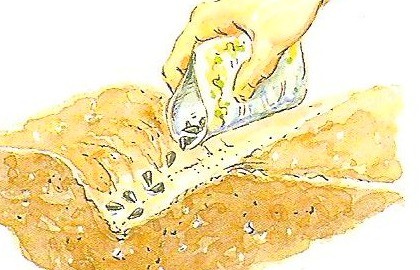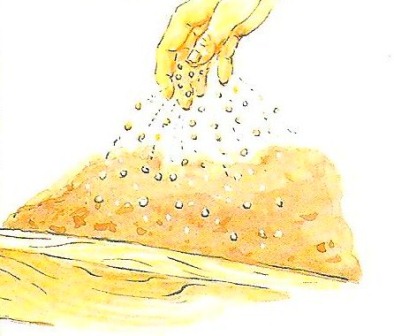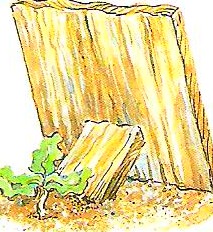|
Spring Vegetable Garden TipsBuilding your spring vegetable garden can be fun and I’m sure you may be thinking “aha!” spring is finally here. Well, I’m going to offer you some free organic gardening techniques that you can incorporate in your garden. I think that spring is a nice time to grow and even fall more in love with your garden as it’s a good time for planting. Here are some free spring gardening ideas… Early Spring Vegetable GardeningIf you have a lot of space, you can even grow some evergreen trees and shrubs to create that sort of edgy green presence. The Best Vegetables to Sow Under Cloches
Feed your spring greens with comfrey liquid or seaweed solution and spread mulch everywhere. Prune your evergreens, conifer hedges as well as your hollow stemmed and borderline hardy shrubs. Spring Vegetable Gardening TipsDig in some compost to aid with transporting nutrients to your plants. If you have a greenhouse, you can sow some cucumbers, peppers and tomatoes as these will grow exceptionally well in there. Supply your lawns and grass with sieved compost or a seaweed solution. Cut them once every week while leaving some clippings for mulch. Move, lay and repair the turf. Replace sticky bands if necessary and protect early flowers and buds against frost. Mid-Spring Vegetable Garden TechniquesYou can plant some onion seedlings, potato sets and perennial herbs as these are an excellent start for mid-spring. Here are some vegetables that you can sow under cloches…
Continue to apply mulch all over and spray everything with some diluted seaweed solution. Prune the early flowering shrubs when the flowers fade and eliminate the seed heads from the bulbs as they die back. To keep your garden free from weeds, weed on a constant basis. Sow some ridge cucumbers, sweet corn, tomatoes, pumpkins and melons in the greenhouse. These will grow very well in there. Cut your lawns and grasses every week to keep them neat. You can continue to use the clippings for mulch. Apply some top dress to your container plantings to boost plant growth. Spring Gardening TipsAdd some slug pubs to keep slugs away from your garden. Lookout for any signs of pests and diseases while keeping an eye on your sticky bands. Protect all of your tender flowers and plants against frost. Late Spring Vegetable Garden TechniquesYou can start off by planting some ridge cucumbers and sweet corn. Then sow melons, pumpkins, tomatoes and sweet corn under cloches. Sow vegetables such as…
in the open. Feed your tomatoes and pot plants with some comfrey liquid or seaweed solution. Add compost to all of your transplants to boost plant growth and production. Mulch under and around your potatoes and spray everything with diluted seaweed solution. Continue to prune early-flowering shrubs as flowers fade. Weed constantly and water autumn along with spring plantings. Additional Tips for Planting Vegetables in SpringTie in and add support to the plants that sprawl and climb as they grow including the tall herbaceous plants. This helps to facilitate the weight of the plants as they grow. When looking for signs of pests and diseases, lookout for aphids, red spider mites and cabbage white caterpillars. Protect your flowers and plants against late frosts. Growing Vegetables in Spring3 Sowing Methods to use in your Spring Vegetable Garden 1. Form shallow furrows to sow seeds in rows. Use a corner of a hoe to create a furrow that’s at the correct depth for the seeds you’re planting. Sow them evenly and pat soil gently over them. 2. Use hills for groups of plants growing in a cluster rather than rows for sprawling plants if you wish. This is where they’ll often grow in a low mound of soil. This method is a traditional way to grow crops such as melons and squash. Sow 5 or 6 seeds in a circle and pat soil over them.  3. When sowing wide bands of vegetables across a bed, use the broadcasting method. This is an excellent space-saving way to grow smaller crops such as lettuce, radishes and carrots.  Now here’s what I mean by the broadcasting method… First, scatter the seeds evenly over the soil. Then cover by scattering soil over the seeds in one direction and then at right angles. Pat the soil to firm it and there you go, see how easy these sowing methods are. Gardening Tips for YouProtecting Young PlantsNewly sprouted seedlings and transplants tend to be vulnerable to unexpected late frosts and hot, sunny weather conditions. However, there’s no need to worry as there are many easy to use devices that can help protect them. Here are 3 protection methods for young plants… 1. Make cloches to fit over the tops of plants to form small single-plant greenhouses that can keep your plants safe on cold nights. You can use a 1 gallon plastic milk jug and cut off the bottom as well as part of the handle. Place the jug over the plant and push a stake through the handle to hold it in place.  Leave the cap off to allow some adequate and proper air ventilation but remember to recap the jug on frosty nights. You can check out mail-order seed catalogs as they offer other types of cloches. 2. Cut out the top of a cardboard box and 3 edges of the bottom. Then, turn the box upside down over a baby plant. Close the lid at night to protect the plant from the cold weather. You can open the lid in the morning.  3. To protect tender young plants from any unexpected hot weather and bright sunshine, prop up a piece of plywood or a shingle. Do that on the sunny side of each plant to provide shade to it. When the plants are well established and developing very well, you can remove the protection. 
|









